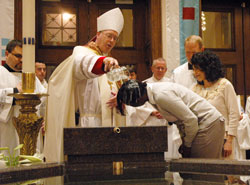Bishop Coyne to be celebrant of Holy Week liturgies at cathedral

Bishop Christopher J. Coyne baptizes Tomiko Whitaker during the celebration of the Easter Vigil on April 23, 2011, at SS. Peter and Paul Cathedral in Indianapolis. Jerry Galooley, right, served as Whitaker’s sponsor. (File photo by Sean Gallagher) Click for a larger version.
By Sean Gallagher
Filled with rituals celebrated only once a year, the liturgies of Holy Week are the solemn high point of the Church’s liturgical calendar.
Bishop Christopher J. Coyne, apostolic administrator, will be the principal celebrant for each of them at SS. Peter and Paul Cathedral in Indianapolis, and looks forward to praying with Catholics from across central and southern Indiana during the liturgies.
While he encourages Catholics to gather for such liturgies at their home parishes, Bishop Coyne also said it is good on occasion to participate in them at the cathedral.
“The celebration of the liturgy by the bishop is at the heart of the Church’s life,” he said. “Each parish celebration and each celebration by a priest or deacon shares in the bishop’s celebration of the liturgy, which in turn is joined to the universal liturgy of Christ, the great high priest.
(Related story: Holy Week liturgies are set at SS. Peter and Paul Cathedral in Indianapolis)
“As a bishop, too, I love to celebrate with people from all over the archdiocese whenever I can. Gathered around the ‘cathedra,’ or ‘chair,’ of the next archbishop, we can celebrate our unity as an archdiocese and continue to faithfully anticipate the naming of our next archbishop.”
The liturgies of Holy Week start with Palm Sunday Mass. They continue with the celebration of the annual chrism Mass, which takes place in the archdiocese on Tuesday of Holy Week.
On Holy Thursday, the Easter Triduum begins with the Evening Mass of the Lord’s Supper, which celebrates the institution of the Eucharist and the priesthood at the Last Supper. The Lenten season ends when the Evening Mass of the Lord’s Supper begins.
Christ’s suffering and death are solemnly recalled during the Celebration of the Lord’s Passion.
The Easter Triduum then culminates with the solemn and joyous celebration of Christ’s Resurrection during the Easter Vigil on Holy Saturday night.
“Aside from the Sunday celebration of Mass, the Easter Triduum is the highlight of our liturgical year,” Bishop Coyne said. “Not only do we initiate and welcome new members into our Church at the Easter Vigil, but in the unity of the three days of Holy Thursday, Good Friday, and Holy Saturday, we encounter the mystery of the life, death and resurrection of Jesus Christ.”
Bishop Coyne pointed out a unique aspect of the liturgies of the Easter Triduum. Mass on Holy Thursday evening begins with the usual greeting, but does not end with the ordinary dismissal. Both are absent from the liturgy of Good Friday. And the Easter Vigil on Holy Saturday night does not begin with the ordinary greeting, but ends with a joyful Easter dismissal.
“This is not by accident. It is by design,” Bishop Coyne said. “The Easter Triduum is intended by the Church to be celebrated as a unity. We are encouraged to see these three days as days of liturgy, prayer and vigil, all joined together, all leading us more deeply into the mystery of faith.” †
